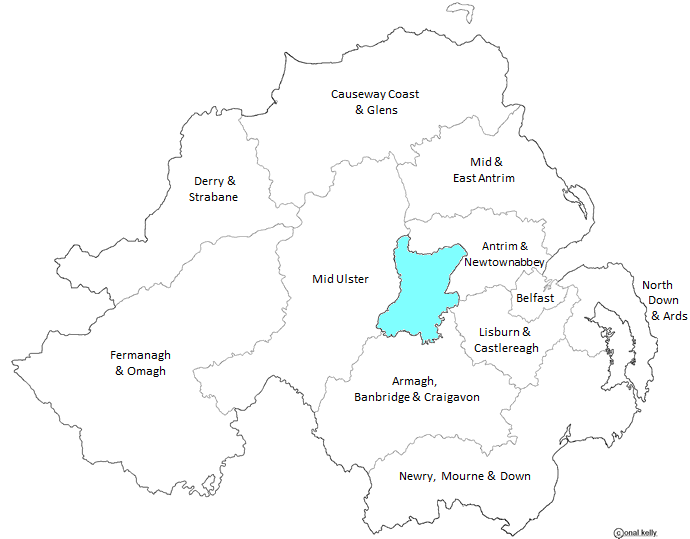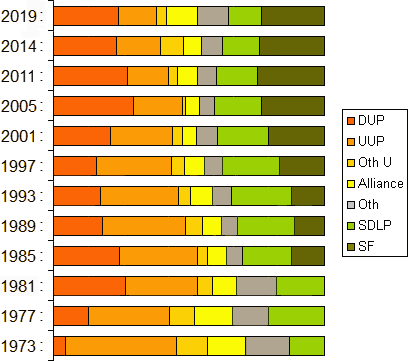

 |
 |
|
|
|
|

|
Map by Conal Kelly
The elections for Northern Ireland's new 11 local councils took
place on 22 May, 2014, simultaneously with the European
Parliament election. Councillors are elected for a four-year
term by Single Transferable Vote from
local electoral areas returning five, six or seven councillors.
These were the first elections to take place on the new District
Electoral Areas for the new councils.
| Party |
Seats 2014 |
Votes (Total) |
Votes (%ge) |
Notional Seats 2011 |
Notional Change |
%ge Change |
| Sinn Fein | 105 |
151,455 |
24.1% |
115 |
-10 |
-0.7% |
| Democratic Unionist Party | 130 | 144,928 |
23.1% |
145 |
-15 | -4.1% |
| Ulster Unionist Party | 88 | 101,386 |
16.1% |
77 |
+11 |
+1.1% |
| Social Democratic & Labour Party | 66 | 85,218 |
13.6% |
67 |
-1 | -1.4% |
| Alliance Party | 32 |
41,770 |
6.7% |
34 |
-2 |
-0.7% |
| Traditional Unionist Voice | 13 | 28,320 |
4.5% |
3 |
+10 | +2.5% |
| Progressive Unionist Party |
4 |
12,753 |
2.0% |
1 |
+3 | +1.4% |
| NI21 | 1 | 11,494 | 1.5% | 0 | +1 | |
| UK Independence Party | 3 |
9,313 |
1.5% |
1 |
+2 | +1.1% |
| Green Party |
4 | 5,515 |
0.9% |
1 |
+3 | -0.1% |
| NI Conservatives | 0 | 2,527 | 0.4% | 0 | 0 | +0.2% |
| People Before Profit | 1 | 1,923 | 0.3% | 0 | +1 | +0.0% |
| Éirígí | 0 | 1,756 | 0.3% | 0 | 0 | +0.0% |
| Workers Party | 0 | 985 | 0.2% | 0 | 0 | +0.1% |
| Fermanagh Against Fracking | 0 | 555 | 0.1% | 0 | 0 | |
| Republican Network for Unity | 0 | 502 | 0.1% | 0 | 0 | |
| Community Partnership | 0 | 388 | 0.1% | 0 | 0 | 0.0% |
| Socialist Party | 0 | 272 | 0.04% | 0 | 0 | -0.1% |
| BNP | 0 | 173 | 0.03% | 0 | 0 | -0.1% |
| Democracy First | 0 | 173 | 0.03% | 0 | 0 | |
| Independents | 15 | 26,675 | 4.2% | 18 | -3 | -0.6% |

This graph contrasts the first preference votes across the whole
of Northern Ireland with those cast in the local government elections
of 2014, 2011, 2005, 2001, 1997, 1993, 1989, 1985, 1981, 1977 and 1973.
| Council | DUP | UUP | TUV | Alliance | Others | SDLP | SF | Total |
| Antrim & Newtownabbey | 15 | 12 | 2 | 4 | 4 | 3 | 40 | |
| Ards & North Down | 17 | 9 | 1 | 7 | 3 Green, 2 Ind | 1 | 0 | 40 |
| Armagh, Banbridge & Craigavon | 13 | 12 | 0 | 0 | 1 UKIP, 1 Ind | 6 | 8 | 41 |
| Belfast City | 13 | 7 | 1 | 8 | 3 PUP, 1 Green, 1 PBP | 7 | 19 | 60 |
| Causeway Coast & Glens | 11 | 10 | 3 | 1 | 1 PUP, 1 Ind | 6 | 7 | 40 |
| Derry & Strabane | 8 | 2 | 0 | 0 | 4 Ind | 10 | 16 | 40 |
| Fermanagh & Omagh | 5 | 9 | 0 | 0 | 1 Ind | 8 | 17 | 40 |
| Lisburn & Castlereagh | 20 | 8 | 1 | 7 | 1 NI21 | 3 | 0 | 40 |
| Mid & East Antrim | 16 | 9 | 5 | 3 | 1 UKIP, 2 Ind | 1 | 3 | 40 |
| Mid-Ulster | 8 | 7 | 0 | 0 | 1 Ind | 6 | 18 | 40 |
| Newry, Mourne & Down | 4 | 3 | 0 | 2 | 1 UKIP, 3 Ind | 14 | 14 | 41 |
| Total | 130 | 88 | 13 | 32 | 28 |
66 | 105 | 462 |
This was the first local government elections to the newly established eleven “super
councils”. The new councils superseded the twenty-six local
government districts established in 1973, which formed the basis
of ten elections between 1973 and 2011. You can look at all the
local election results since 1973 here,
and compare specifically
with the 2011 elections here, the 2005 elections here, the 2001 elections here, the 1997 elections here and the 1993 elections here. (See spreadsheet archive.)
The reform of local government had been a protracted process with the initial proposal for seven councils being made in 2005 by then Secretary of State Peter Hain. This was later supplanted by proposals brought forward by the Executive in March 2008 recommending eleven councils. In June 2012, the Northern Ireland Assembly finally approved the draft Order specifying the new eleven districts with names and boundaries as outlined in the map above.
The ward is the primary unit of electoral geography and represents the building blocks for the new local government districts. A ward cannot be divided between districts and must be contiguous to at least one other ward within the district (except where the ward consists of an island). The new structure sees a reduction in the number of local government wards from 582 to 462. The number of wards designated per district is as follows: Belfast has 60 wards; Armagh, Banbridge and Craigavon district and Newry, Mourne and Down district both have 41 wards; the remaining eight districts have 40 wards each. The number of wards a distrct has is the equivalent of the number of councillors to be elected. The map of the new electoral wards is outlined below:
Map by Conal Kelly
The District Electoral Area (DEA) is a distinct territorial subdivision of the local government district. It is comprised of between five and seven wards and is the focus of separate electoral contests. Under the new local governemnt model, 80 DEAs have been established. They comprise 34 five ward areas; 30 six ward areas; and 16 seven ward areas encompassing all 462 wards. Each of the new local government districts consists of seven DEAs with the exception of Belfast which has ten. The map of the new district electoral areas is outlined below:
Map by Conal Kelly
See also:
Other sites based at ARK: ORB (Online Research Bank) | CAIN (Conflict Archive on the INternet) | Northern Ireland Life and Times Survey
Your comments, please! Send an email to me at nicholas.whyte@gmail.com.
Nicholas Whyte, 1 January 2015. Updated by Conal Kelly, 4 January 2015.
|
|
Disclaimer:© Nicholas Whyte 2005 Last Updated
on Tuesday, May 10,
2005 23:32:51
|